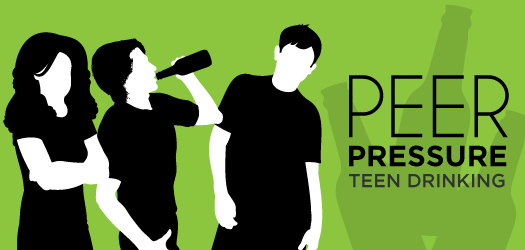Article Contributed by: Lauren N. Hardy, MA, clinical team member of Lakeview Behavioral Health

More teenagers and adolescents are using alcohol at earlier ages than in previous years; over half of the people in the U.S. between ages 12 and 20 have imbibed alcohol at least once. The average age for a girl living in the United States is now 13; average age for a boy is 11 [1].
Underage drinking is a far-reaching problem that can lead to severe, often deadly, consequences.
There are a variety of reasons that a teenager may experiment with alcohol such as:
- Genetics
- Gender
- Mental health disorders
- Personality traits
- Peer pressure
Peer pressure is the social influence to adopt a certain type of behavior, style of dress, or attitude as a way to be accepted as part of the group. There are two types of peer pressure. Positive peer pressure can influence healthy behaviors, such as exercising or eating well, while negative peer pressure can lead teens to engage in risky activities and behaviors in order to fit in.
Growing Up with Peer Pressure
While peer pressure begins during the preschool years, it becomes incredibly important, as children become teenagers, a time at which wanting to fit in, being accepted by peers, and being a part of a group becomes of the utmost importance.
The brain is maturing during these years, and the still-developing brain functions can make it far harder for teens to resist the pull of peer pressure. During these years, teens are drawn toward immediate gratification while learning to control their impulses and resist pressure from others.
The teen years are some of the most developmentally significant of a person’s entire life and the changes that a teen faces prepare him or her for the challenges of adult life. While this can be full of tremendous excitement and personal growth, teens are at risk for a variety of problems, many related to alcohol and addiction.
When Does Drinking Start to Happen?
The highest prevalence of drinking occurs between the ages of 18 and 25 [2] and the consequences of problem drinking during this time can last a lifetime. Binge drinking, or having five or more drinks for a boy or four or more for a girl, is especially prevalent during this time in an adolescent’s life and can lead to serious complications.
People who binge drink often:
- Pass out
- Lose memory of events that happened while they were drunk (black outs)
- Miss school
- Act in uncharacteristic ways
Some teens who binge drink may do so on a regular basis while others may occasionally binge drink after getting carried away. Teens who binge drink are eight times more likely than other students to fall behind in their school, injure themselves, damage property, and miss classes [3].
Risks of Binge Drinking
One of the biggest risks for binge drinking among teens is alcohol poisoning (often called an “alcohol overdose”), a potentially lethal health complication. As alcohol is a central nervous system depressant. Too much alcohol can cause complications in virtually every organ system – especially those involved in maintaining vital functions.
Alcohol poisoning can cause a dramatic drop in:
- Blood pressure
- Heart rate
- Decreased respiration
- Loss of consciousness
Alcohol poisoning is a medical emergency and teens may not immediately recognize the signs of this potentially lethal condition. If left untreated, alcohol poisoning may lead to coma and death. Alcohol poisoning isn’t the only type of life-threatening complication that teens face while drinking alcohol.
The Consequences of Underage Drinking
Every year in the United States, about 5,000 people under the age of 21 will die from underage drinking. This number includes approximately:
- 1,900 deaths from motor vehicle crashes
- 1,600 deaths from homicides
- 300 as a result of suicide
- Countless others from injuries such as:
- burns
- falls
- drowning
Teens that drink alcohol are at a higher risk for becoming one of the statistics and for behaving in a risky manner such as:
- Abuse of other drugs
- Having multiple sexual partners
- Practicing unsafe sex
- Poor academic performance [2]
Each year, nearly 100,000 students between the ages of 18 and 24 are the victim of alcohol-related sexual assault and date rape [1].
The Health Risks of Underage Drinking
Additionally teens who use alcohol are at risk for addiction and potential health risks. It appears that there are subtle changes in the structure and function of the still-maturing brains of teens who drink. The teen years have a remarkable amount of hormonal changes, especially the sex hormones – testosterone and estrogen, which are vital for proper growth and development.
Drinking alcohol during this time can upset the hormone balance needed to maintain normal growth of muscles, organs, and bones. Some adolescents who drink alcohol have elevated liver enzymes, an indicator of liver damage, that can, over time, lead to scarring and cirrhosis of the liver [2].
While drinking heavily at any point in a person’s lifetime can lead to serious complications, those faced by teens can be dire. It is clear that teenage drinking is becoming out of control and a serious problem in the United States and worldwide.
References:
[1]: http://www.helpguide.org/harvard/alcohol_teens.htm
[2]: http://pubs.niaaa.nih.gov/publications/AA67/AA67.htm
[3]: http://www.helpguide.org/harvard/alcohol_teens.htm
Author: Lauren N. Hardy, MA, clinical team member of Lakeview Behavioral Health. With several years of experience in the treatment field, two years as a research analyst at Vanderbilt University and masters in counselling psychology, Lauren provides a professional insight teens, alcohol abuse and peer pressure.
Last Updated & Reviewed By: Jacquelyn Ekern, MS, LPC on February 21, 2014
Published on AddictionHope.com, Internet Information for Alcohol Abuse
